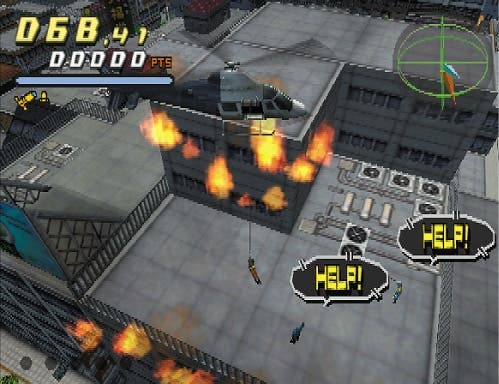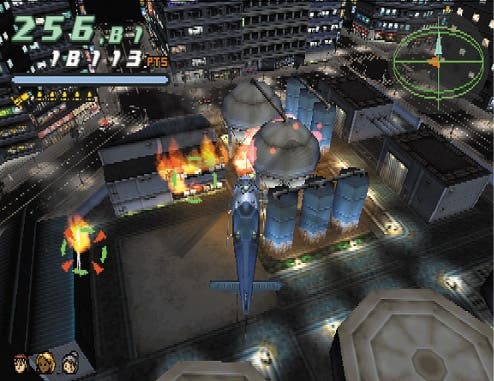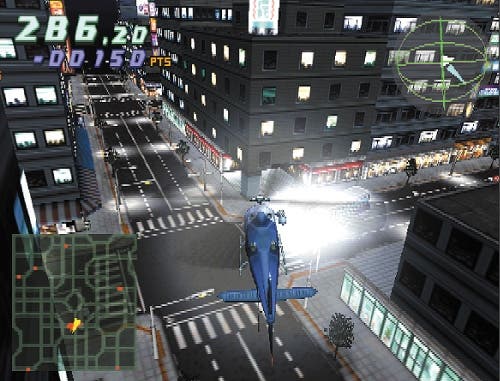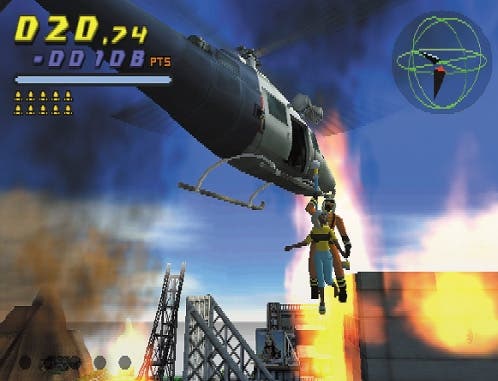City Crisis
Review - imported from Japan with an aim to innovate, Syscom's City Crisis still has a lot of work to do to impress Mugwum

Search & Rescue
Helicopter games are big business on the PC, but it wasn't until Sim Copter that anybody did a fair old search-and-rescue simulation. We imagine this is because generally speaking the idea isn't that enthralling. Syscom would contest that though, and shove console helicopter romp City Crisis under your nose to prove the point. The thing is, despite my lust for original game concepts (I bought Startopia, I can prove it) after a week with City Crisis I'd turn my nose up if given the opportunity again. It just doesn't feel like a finished game. For starters, it looks really pants. Admittedly, I came to it off the back of Gran Turismo 3, surely the bastion of PlayStation 2 visuals, but I doubt City Crisis is even using half of the system's power to flaunt itself. Two minutes in and I'm overwhelmed by the damn interlace flickering, something I thought we did away with about ten steps further on from the console's launch titles. The texturing is of a very low resolution, reminding me of the urban settings from last year's Spider-Man on the PlayStation, a system with only a fraction of the PS2's power, and repeating every five metres in any given direction. Another characteristic inherited from Spider-Man is the hanging drapes effect. Textures don't look like textures, they appear to be bits of cloth stapled to the walls rippling in the wind. They wobble all over the place - it's not pretty.

Wrong system
Another issue are the actual polygonal structures. A water tower appears to be hexagonal rather than circular when viewed from above, and even the slightest variation from the classic big cubic box of the main buildings is accentuated by a complete lack of any visible curves. Given the consistent framerate surely they could have spent a bit of time here lavishing some detail. Since when do roads bend at 45-180 degrees on a sixpence? Even the helicopter model itself is flaky. The blades seem to spin reasonably but they don't look all that realistic; more like a transparent disc attached to the top of the chopper that whirrs out of your speakers. You can actually see through the helicopter's open compartment, but that's about as far as the detail goes. Decked out in gunmetal blue and grey, it looks pretty functional, and the skis form a sort of double arch under the helicopter, which when viewed up close looks like one half of a barrel glued on to the undercarriage. There's some sort of light or speaker or something on the side, which I'm sure fits in with normal helicopter design, but it looks really out of place. On the whole the game looks like it should have come out on the PSOne. There's no place for it amongst the likes of Onimusha, Gran Turismo 3 and their ilk, and the aliasing is really bad. This could be enough to put off a lot of you at the first hurdle. Continuing the trend of PSOne-ishness is the lacklustre audio accompaniment; unremarkable helicopter sounds that cover the spinning of the rotors, crashing and other basic effects, no soundtrack to speak of, and little to engender a low whistle of admiration.

Chopped up
The actual game, as you've probably guessed, is about rescuing people from fires and other hazardous urban emergency situations using a helicopter. There are three modes of play; Training, Time Attack and Mission, and beyond that nothing. The Training mode gets you to grips with the helicopter, courtesy of some pretty basic manoeuvres in the air. This is well worth completing before you try anything else. Mission mode is the focal point of the game (obviously, since the rest of it is so mediocre), and players can pick from a selection of available missions that are classed as rescue, chase or final rescue. In Rescue mode, players fly around in their preferred helicopter either putting out separate fires or saving lives before the time runs out. Chase missions involve lending your skills as a chopper pilot to the local constabulary, who are pursuing suspects. Your job is to find the suspects and shine a searchlight on them for as long as possible so that the rozzers can nab 'em. Final rescue, the final mission of the game funnily enough, features a mixture of everything you do during the course of the game.

Missed opportunity
In spite of the insipid visuals and dreary audio, this game of throwaway heroism could actually be quite fun, but unfortunately like so many other so-called concept games, it's let down again by a questionable control system. Over-complicated is the key; you use your left analog stick to control movement, while the right analog stick handles turning and altitude. Hang on, turning and altitude? Yes, although this sort of control works fairly well as a rule using a D-pad or the right-hand buttons, you're required to use the analog stick in City Crisis, and it's ever so easy to turn left when you're actually just trying to bob a little bit higher in the air. The camera angle doesn't help one bit either. The height of the buildings is almost indeterminable from the position you view the game (above and behind). If there was an option to switch to an in-cockpit view perhaps things would be simpler, but there isn't and it hurts. Take 2 are pushing City Crisis with a firm paw, hoping that the original concept will be lapped up by PlayStation 2 owners crying out for something new to do. Unfortunately the game is more reminiscent of something pulled out of the PSOne's back catalogue from a year ago. Shoddy visuals and unimaginative audio are bad enough in light of recent PS2 releases, but coupled with a lean single player game, a lack of any sort of multiplayer and irritating controls the game simply isn't worthy of your time or money.

